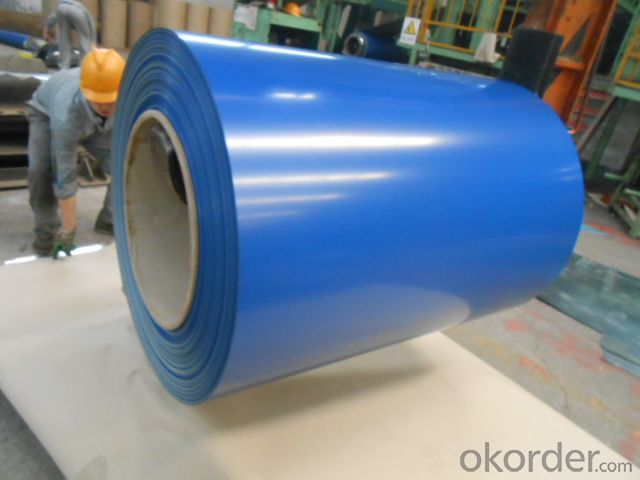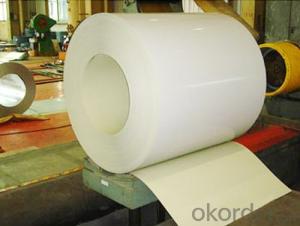Pre-Painted Steel Coil White Color Prime Quality
- Loading Port:
- Tianjin
- Payment Terms:
- TT or LC
- Min Order Qty:
- 50 m.t.
- Supply Capability:
- 1000 m.t./month
OKorder Service Pledge
OKorder Financial Service
You Might Also Like
1. Pre-Painted Galvalume Steel Coil Description:
With GI as base material, after pretreatment (degrease and chemical treatment ) and liquid dope with several layers of color, then after firing and cooling, finally the plate steel is called prepainted galvanized (aluzinc) steel. Prepainted galvanized steel is good capable of decoration, molding, corrosion resistance. It generally displays superior workability, durability and weather resistance.
2.Main Features of the Pre-Painted Galvalume Steel Coil:
• Excellent process capability
• Smooth and flat surface
• Workability, durability
• Excellent heat resistance performance
• High strength
• Good formability
• Good visual effect
3.Pre-Painted Galvalume Steel Coil Images

4.Pre-Painted Galvalume Steel Coil Specification
Standard: AISI, ASTM, BS, DIN, GB, JIS
Grade: DX51D, DX52D
Thickness: 0.17-2.0mm
Brand Name: KMRLON
Model Number: coil
Type: Steel Coil
Technique: Cold Rolled
Surface Treatment: Coated
Application: Boiler Plate
Special Use: High-strength Steel Plate
Width: 20-1250mm
Length: customized
commoidty: pre-painted galvanized steel coil
Thickness: 0.13-4.0mm
width: 20-1250mm
zinc coating: 40-180g/m2
printing thickness: top side: 20+/-5 microns, back side: 5-7 microns
color: all RAL color
surface treatment: color coated
coil weight: 4-7 tons
coil ID: 508/610mm
packaging: standard seaworthy packing
5.FAQ of Pre-Painted Galvalume Steel Coil
1. What’s the application of this product?
Roof, roof structure, surface sheet of balcony, frame of window, etc.
2. What’s the brand of the paint?
We use the best brand of all of the word—AKZO.
3. How to guarantee the quality of the products?
We have established the international advanced quality management system,every link from raw material to final product we have strict quality test;We resolutely put an end to unqualified products flowing into the market. At the same time, we will provide necessary follow-up service assurance.
4. How long can we receive the product after purchase?
Usually within thirty working days after receiving buyer’s advance payment or LC. We will arrange the factory manufacturing as soon as possible. The cargo readiness usually takes 15-25 days, but the shipment will depend on the vessel situation。
- Q:What are the common coil loading and unloading procedures?
- Common coil loading procedures involve using cranes or forklifts to lift and position coils onto trailers or flatbed trucks. The coils are typically secured using straps, chains, or coil racks to prevent shifting during transportation. During unloading, the same equipment is used to carefully lift and remove the coils from the truck, ensuring safety and stability throughout the process.
- Q:What are the different types of steel coil edges?
- There are several different types of steel coil edges, each with its own unique characteristics and applications. 1. Mill Edge: This is the most common type of steel coil edge. It is produced by cutting the coil at the mill and does not undergo any additional processing or treatment. Mill edge coils have a natural, slightly rounded edge, which makes them suitable for a wide range of applications. 2. Slit Edge: Slit edge coils are created by cutting the coil along its width using a slitting machine. This process results in a straight and smooth edge, making them ideal for applications that require precise measurements, such as automotive parts or electrical components. 3. Deburred Edge: Deburred edge coils have undergone an additional process to remove any burrs or sharp edges that may be present after slitting. This makes them safer to handle and reduces the risk of damage during fabrication or installation. Deburred edge coils are commonly used in the construction industry, especially for structural steel components. 4. Rounded Edge: As the name suggests, rounded edge coils have a rounded edge profile. This type of edge is achieved through a specific rolling process that creates a smooth and curved edge. Rounded edge coils are often used in applications where safety is a concern, such as in the manufacturing of household appliances or kitchen equipment. 5. Sheared Edge: Sheared edge coils are produced by cutting the coil with shearing blades, resulting in a straight edge with a slight burr. While sheared edge coils may have a rougher finish compared to other types of edges, they are still commonly used in applications that do not require a high level of precision, such as general fabrication or shelving. Overall, the choice of steel coil edge depends on the specific requirements of the application, including factors such as measurement precision, safety considerations, and aesthetic preferences.
- Q:I just got a set of all-clad Stainless steel frying pans, they are very nice yet they didn't come w/ instructions to care for them. I have never cooked w/ stainless steel cookware so I really don't know much about them. I was told they should have a lifetime warranty on them, but I don't want to reck them. I would appreciate any information I can get on stainless steel cookware. Thanks.
- I bought a badly scratched-up 11 inch All-Clad Frying pan off Ebay for $23.00. I needed a large all-clad frying pan. I took it out to the garage and first cleaned it with an 8 wire brush on my bench-top polishing / grinding machine. Then I installed a 8 polishing wheel on the bench grinder. I used some polishing creme I use on car parts that I bought from Caswell s Plating. Auto polishing for your car will work too. The outside polished up like a mirror - as good as my new All-Clad pieces. Remember people. This is stainless steel. It s a tough, tough metal. You can work it like a piece of metal just as All-Clad did at the factory where they made it. It would take years to wear through the first stainless layer with a polishing wheel and mild auto polishing creme just as it would take a lot to wear through your cars paint. After-all; All you are doing is preparing an optical surface.
- Q:Can steel coils be coated with chemical-resistant materials?
- Yes, steel coils can be coated with chemical-resistant materials. These coatings are designed to protect the steel surface from the corrosive effects of chemicals or other harsh substances. The chemical-resistant coating forms a barrier that prevents the chemicals from directly interacting with the steel, enhancing its durability and longevity.
- Q:...particularly for jewelry?
- Stainless steel is steel with lots of carbon in it. The amount of carbon gives it a so called grade. Marine grade, surgical grade etc.
- Q:What is the strongest steel ever made.
- tungsten steel
- Q:What are the common coil thickness tolerances?
- The common coil thickness tolerances can vary depending on the specific industry and application. However, in general, common coil thickness tolerances range from +/- 0.001 to +/- 0.010 inches.
- Q:How are steel coils used in the production of steel latches?
- Steel coils are used in the production of steel latches as they serve as the raw material for manufacturing these components. The coils are processed through various manufacturing steps, such as cutting, stamping, and forming, to shape them into the desired latch design. These transformed steel coils are then further treated with coatings or finishes to enhance their durability and corrosion resistance. Ultimately, steel coils play a crucial role in providing the base material necessary for creating sturdy and functional steel latches.
- Q:How are steel coils used in the production of structural components?
- Structural components heavily rely on steel coils throughout the production process. These coils, made from rolled steel strips, serve as the essential raw material for manufacturing various components like beams, columns, and trusses. The initial step in utilizing steel coils for structural components involves uncoiling the strip and cutting it into desired lengths. This can be achieved using diverse cutting methods, such as shearing or sawing. Once the coils are cut into appropriate lengths, they undergo further processing to shape them into specific structural components required for a particular project. One prevalent approach to shaping steel coils into structural components is through bending or forming. This necessitates the use of specialized machinery to bend or shape the steel into the desired configuration. For instance, a steel coil can be bent into an I-beam shape, commonly employed as a load-bearing component in buildings and bridges. Another technique employed for shaping steel coils into structural components is welding. This involves joining multiple steel coils together to create larger components. Welding is often employed to fabricate components like columns or trusses, which demand the combination of multiple steel coils to achieve the required strength and structural integrity. Once the steel coils have been shaped and formed into the desired structural components, they may undergo additional processes, including surface treatment or coating, to enhance their durability and resistance to corrosion. This ensures that the components will endure and withstand the demands of their intended applications. In conclusion, steel coils are crucial in manufacturing structural components as they provide the necessary raw material. Through cutting, bending, and welding processes, steel coils are transformed into the specific components needed for various construction projects. These components play a vital role in supporting the structural integrity of buildings, bridges, and other structures.
1. Manufacturer Overview |
|
|---|---|
| Location | |
| Year Established | |
| Annual Output Value | |
| Main Markets | |
| Company Certifications | |
2. Manufacturer Certificates |
|
|---|---|
| a) Certification Name | |
| Range | |
| Reference | |
| Validity Period | |
3. Manufacturer Capability |
|
|---|---|
| a)Trade Capacity | |
| Nearest Port | |
| Export Percentage | |
| No.of Employees in Trade Department | |
| Language Spoken: | |
| b)Factory Information | |
| Factory Size: | |
| No. of Production Lines | |
| Contract Manufacturing | |
| Product Price Range | |
Send your message to us
Pre-Painted Steel Coil White Color Prime Quality
- Loading Port:
- Tianjin
- Payment Terms:
- TT or LC
- Min Order Qty:
- 50 m.t.
- Supply Capability:
- 1000 m.t./month
OKorder Service Pledge
OKorder Financial Service
Similar products
New products
Hot products
Related keywords






























